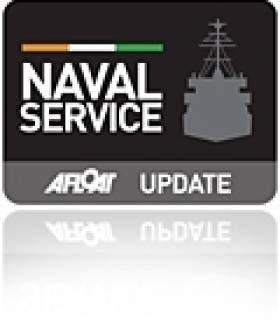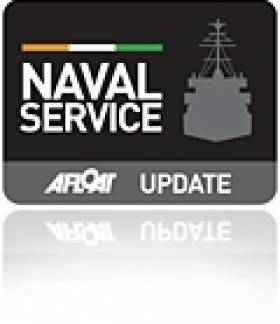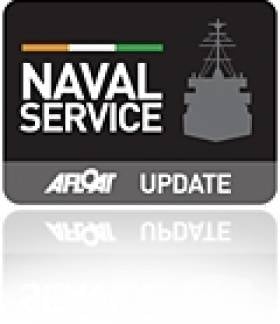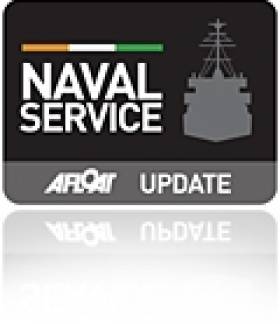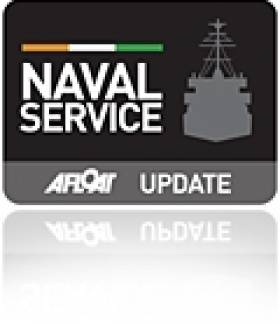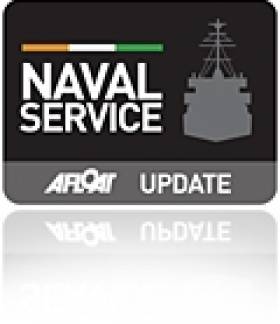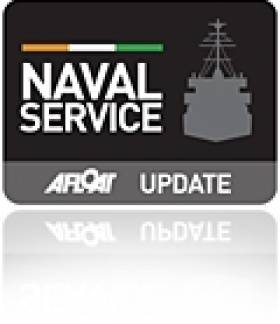Displaying items by tag: Navy
A Flying Send-Off as L.E. Emer Bids Dublin Bay Farewell
#FarewellEMER - Today the sell-listed L.E. Emer (P21) departed Dublin Port for the final time and it was also the Naval Service OPV's last patrol, writes Jehan Ashmore.
She headed out of Dublin Bay under the command of Lt .Cdr. Alan O'Regan and where she set a southerly course to pass the Muglins off Dalkey Island.
At the same time of her late morning exodus of the bay, a former World War II serving Catalina flying-boat soared above. The distinctive aircraft was heading eastwards over the Irish Sea, having taken part in yesterday's Flight Fest hosted in the capital.
L.E.Emer is scheduled to complete her patrol duties next Friday at the Naval Base in Haulbowline, Cork Harbour.
She will be decommissioned and next month put up for public auction unless previously sold. A pair of replacement OPV newbuilds are under contruction in the UK with the first of the improved 'Roisin' class due for delivery next year.
Flight Fest Flyover Above Dublin Port Sees Return of ‘Farewell’ L.E. Emer
#FarewellEMER – This Sunday's spectacular Flight Fest Flyover above Dublin Port and city-centre quays is from where the event is to be officially launched by the LE. Emer (P21), writes Jehan Ashmore.
The return to Dublin Port of the sell-listed Naval Service offshore patrol vessel follows a recent call to the capital only last week. On that occasion she made a special farewell cruise in Dublin Bay for former sailors.
So it transpires that this visit to Dublin Port is in fact likely to be her 'final' call to the capital while also performing her last patrol duties.
The 1978 built veteran is to decommission on 20 September and if not previously sold the 65.5m long vessel is to go for public auction next month.
Naval Service Represented in New Stamps to Honour Defence Forces 60 Years of Overseas Service
#NavalService - More than 60 years of overseas service by the Defence Forces are to be honoured in a set of stamps launched today. The four-stamp set depicts the four branches of the forces – the Army, Naval Service, Air Corps and Reserve Defence Force.
Speaking at the stamps launch, Lieut Gen Conor O'Boyle, chief of staff of the Defence Forces, said: "I am very appreciative to An Post for their work in issuing this special commemorative set of stamps as a salute to the modern Irish Defence Forces. For more on the launch, The Irish Times reports.
Afloat.ie adds that among the quartet of stamps appropriately sold at 60 cents each, is the Naval Service represented by the OPV L.E. Niamh (P52). Astern of the 'Roisin' class vessel is the former Royal Navy Peacock class CPV HMS Swift now L.E. Orla (P41).
As previously reported, the sell-listed L.E. Emer made an historic first as she became the first ever Naval Service vessel to re-supply troops serving with the UN in The Lebanon during 1979, the year in which she was commissioned.
L.E. Emer: A Career Stretching Beyond Fishery Patrols to The Lebanon
#FarewellEMER – Dublin Port is to bid farewell to L.E. Emer (P21) on her final visit to the capital today. Under command of Lt. Cdr. Alan O'Regan she is to resume her last patrol prior to de-commissioning on 20 September, writes Jehan Ashmore.
The sell-listed offshore patrol vessel (OPV) of 1,019 displacement tonnes has served the Naval Service dutifully for nearly 35 years.
Since her launch from the V.C.D. shipyard in 1977, the vessel which entered service two years later, has carried out numerous patrols. Not just fishery monitoring patrols but varied tasks among them the interdiction of illegal drugs and contraband to search and rescue (SAR).
Naval Service vessels are not restricted to domestic waters but also re-supply missions to Irish Army troops serving the United Nations (UN) overseas.
A notable historic first role was undertaken by L.É. Emer, as she became the first ever Naval Service vessel to re-supply troops serving with the UN in The Lebanon during 1979, the year in which she was commissioned.
The 65m vessel is fitted with the following weaponary where the main armament consists of a Bofors 40mm L70 Canon, secondary armament is 2 X 20mm Rheinmetall RH202 Canon. In addition to small various arms ranging from 9mm Pistol to 7.62mm General Purpose Machine Guns mounted amidships.
Another significant operation by the L.E. Emer was the apprehension of the trawler, Marita Ann in 1984, which was stopped after warning shots were fired, having found to be carrying a significant quantity of arms and ammunition.
L.E. Emer Makes Farewell Patrol ‘Cruise’ in Dublin Bay
#FarewellEMER – L.E. Emer (P21) has completed a four-hour farewell patrol 'cruise' in Dublin Bay today for former crew members of the 1978 built vessel, writes Jehan Ashmore.
The Naval Service offshore patrol vessel (OPV) had on board both members of the The Naval Association and Merchant Navy and where no doubt numerous naval career stories were recalled down through the years.
She slipped her moorings this morning and departed Dun Laoghaire Harbour and made a clockwise circuit of Dublin Bay, passing the Baily Lighthouse, rounding the North Burford bouy and then proceeded south before reaching off Killiney Bay.
In calm sunlight seas she stayed in these waters before slipping through Dalkey Sound to Scotsman's Bay and off Sanycove Point, she also momentarily took some time there before she headed to dock in Dublin Port just after lunchtime.
At the next berth is the French Navy's mine-warfare vessel Croix du Sud which arrived this morning.
Yesterday, L.E. Emer made the short passage from an anchorage call off Skerries to Dun Laoghaire Harbour where tours of the vessel were made to the public while berthed at Carlisle Pier.
As previously reported, L.E. Emer is to be de-commissioned on 20 September and in the following month a pubic auction is to take place to sell the 35 year veteran unless previously sold.
British Fishing Vessel Detained by Navy off Mizen Head
#FishingDetention – A British registered fishing vessel was detained yesterday by the Naval Service OPV L.É. Aoife (P22) approximately 90 nautical miles south west off Mizen Head, Co Cork.
The detention was in relation to an alleged technical breach of fishing regulations. The vessel was escorted by the L.É. Aoife to Castletownbere earlier today, and handed over to An Gardaí Síochána.
According to the Naval Service, this brings to a total of 730 vessels boarded in 2013. There have been 24 warnings issued and this is the 7th vessel detained by the Naval Service so far this year.
#navy – Cork Auctioneer Dominic Daly is to sell the Navy Vessel LE Emer (P21) in early October. The Auctioneer, who recently handled the public auction of the Clipper Faith Cargo vessel for the Admiralty Marshall, confirmed arrangements are now in place with the Department of Defence to dispose of the ship this Autumn. Interest could come from a variety of sources including the conversion of the ships for the superyacht market or use as an offshore energy supply boat or a research vessel.
A year later the sister ship LE Aoife (P22) will also go on the market. Both ships are being replaced with new builds for the Irish Naval Service.
As Afloat.ie reported in May, the two Irish-built navy patrol ships launched at Verolme Cork Dockyard, are to be sold off after 40 years of service.
LE Emer (P21) and a sister ship LE Aoife (P22) were built between 1978 and 1980 at the Rushbrooke shipyard near in Cobh, Co Cork.
The first ship of four in the Offshore Patrol Vessel (OPV) class built in Cork in 1972, the LE Deirdre (P20) , was decommissioned in 2001 and sold for €190,000. She was later converted into a luxury yacht.
The two ships will be replaced by two new OPVs currently under construction in the UK.
#FemaleCaptains -For the first time the command handover ceremony between female captains of the Naval Service took place in Waterford City quays on Friday.
The ceremony held on board L.É. Aoife (P22) saw outgoing Captain, Lieutenant Commander Erika Downing hand over to Lieutenant Commander Marie Gleeson.
Waterford was approriately the location for the historic occasion as L.É. Aoife's adopted home-port is the south-eastern city. All Naval Vessels are individually associated with ports around the coastline.
Female personnel first joined the Irish Naval Service in 1995. Eighteen years later female personnel are fully operationally deployed and integrated, making significant contributions to the Naval Service whilst advancing their careers in line with their male colleagues.
Currently one in four of serving Naval Officers are female and earlier this year the Navy promoted two female Non Commissioned Officers (NCOs) to the senior enlisted rank of Petty Officer.
Novel Nobel Names for Naval Service Newbuilds
#NavalNewNames – According to The Irish Times, the Government has decided to name the two new OPV patrol vessels after Nobel prize-winning Irish writers. The move is a departure from the policy of naming vessels after female mythical figures.
The newbuilds are to be named L.E. Samuel Beckett and L.E. James Joyce, the first of the pair is due for delivery in early 2014 and the second in 2015 respectively.
As previously reported on Afloat.ie, the keel-laying ceremony of the first of two PV90 OPV's took place more than a year ago at Babcock Marine's shipyard in north Devon. They are an enhanced version of the 'Roisin' (PV80) class and are to be 10m longer.
Irish-Registered Trawler Detained by Navy off Hook Head
#TrawlerDetained – According to The Irish Times, the Naval Service CPV LÉ Orla (P41) detained an Irish-registered fishing vessel yesterday about 50 nautical miles off Hook Head, Co Wexford.
The detention was in relation to an alleged breach of fishing regulations. The vessel was escorted last evening by the LE Orla to Dunmore East, Co Waterford and handed over to the Garda for further investigation.
This latest detention brings to 507 the total number of vessels boarded by the Naval Service in 2013, with 713 warnings issued and is the 6th vessel detained by the navy so far this year.



























